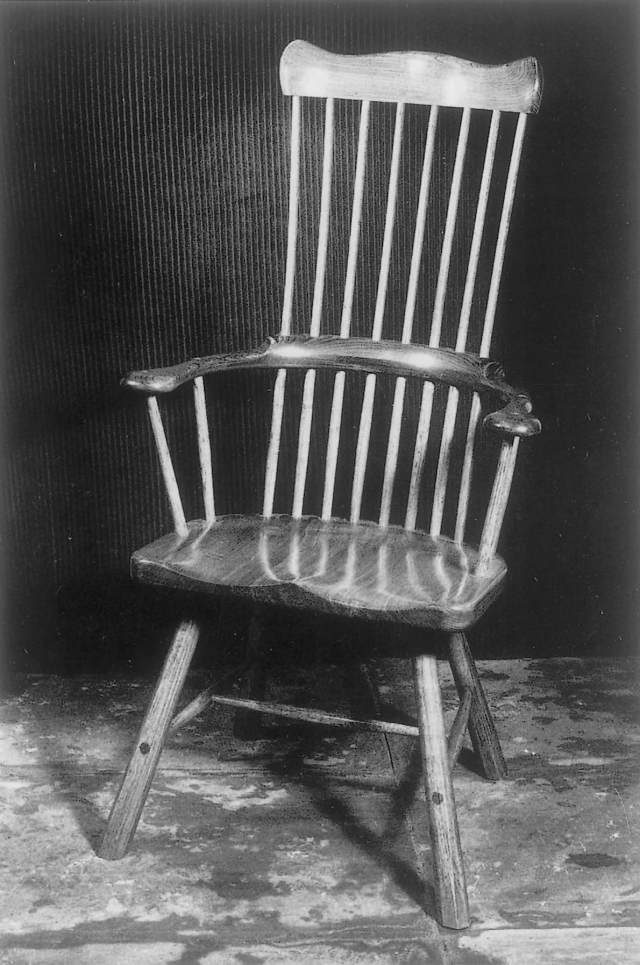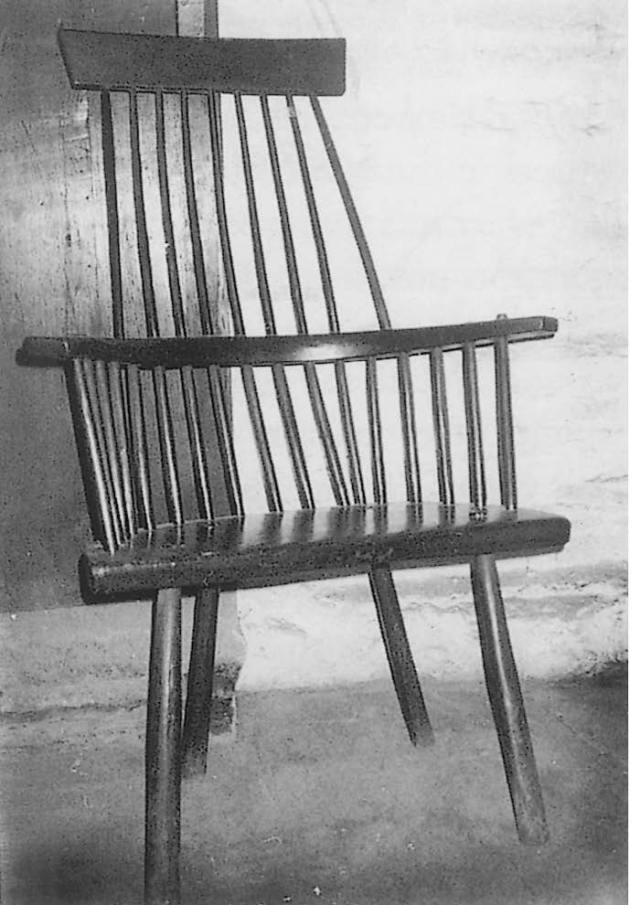
The following is an excerpt from “Welsh Stick Chairs” by John Brown.
“Life without Industry is guilt, and Industry without Art is brutality”
I came back to live in Wales in 1975. I had been made redundant and I was depressed. After years in a job I loved I had been told to go; my skills were no longer appropriate. I had been building wooden boat hulls for years, but now they needed men who could laminate plastics. Had I been prepared to don a plastic boiler suit, wear a respirator and work with nasty, sticky, smelly chemicals, I could have stayed. But I am an uncompromising woodman, I love it. My employers thought the adze as dead as a dodo, so they gave me a small handful of money and told me to pack my box. As I lived in a seaside resort there was not much work that I could do. I wasn’t cut out for selling ice-creams, no killer instinct! My mortgage would be unpayable without a good job. There were plenty waiting to buy my house, so I sold.
I was seven-years-old when we moved from the safety of a large family in the valleys of Wales. Auntie was school-teaching in Kent, Dad came out of the pit and became a bricklayer. So, after a lifetime away, I returned to the ‘Land of my Fathers’. What sort of a living could I make in Wales? There was plenty of building work, but I have a horror of the ‘wet-trades’. I can only work in wood. One day I saw a chair in the window of an antique shop in Lampeter. It was like a vision. I had never seen anything that had made so instant an impression on me. To my eyes this chair was beautiful. I had never had any interest in furniture or chairs. Like most people they were just the things you lived with. Now here was this lovely chair. I couldn’t afford to buy it, but I could make one like it. Well, that is what I did. I made one. It took a long time. Chairs of simple form like the stick chair are surprisingly tricky to make. When you’re building them you have to work from points in the air, angles of sticks, angles of legs; there are so many variables. Anyway, I was quite proud when I finished my chair. It looked alright. Of course, I wasn’t able to put a century or two of patina on it. Now, twelve-years-old, it begins to look right. Family “treatment” and a few thousand hours of bum polishing have done the trick!
At this stage I was interested enough to look for books on the subject. There are quite a few, both American and English. I still hadn’t realised that what I had seen in that Lampeter shop was something quite rare and unique – a Welsh chair. Then it was just a Windsor chair. I went to museums. I visited High Wycombe where there is a museum devoted entirely to Windsor chairs. They have a very comprehensive selection of Wycombe factory chairs and English regional chairs. I don’t think there were any Welsh chairs. The English chairs did not have the same spontaneity the same verve as their Welsh counterparts.
I enjoyed my youth. After the valleys I thought England was wonderful. The war started and we could not live in London, and through a series of events of which I have no knowledge, we ended up with a small-holding in the wilds of Kent. (There were wilds in Kent in those days!) We had no electricity, gas or sanitation, we grew much of our own food and kept chickens and a pig. We didn’t realise it then, but we were living the ‘Good Life’. We made few demands on the world’s resources, and I was happy. So, as the Lampeter chair was one step towards my rehabilitation, the building of a tin shed in a field I bought, and
a change to the simple life, completed my return. I live very happily without electricity or any other services. I have a workshop, a wood stove and good health. There’s a saying applied to yachts, which applies equally to life, “Add lightness – and simplify.”
A neighbour asked me to build him a chair like mine. I tried to – but it came out different. It was alright, but it wasn’t the same chair. My neighbour was pleased. He has the chair now, he keeps it in the bookshop he owns. It then occurred to me that the reason for the diversity of pattern in the old Welsh
chairs was that the makers did other things as well. They were not chair-makersas such, they were wheelwrights, coffin-makers, carpenters, even farmers. When there was need for a chair, somebody in the village made it, or they made their own. They didn’t have patterns and jigs for continuous production. They had no consistent supply of uniform material. They used their eyes and their experience. It was like a sculptor doing his work, they ‘thought’ the chair, then they built their ‘think’. Some of these chairs are a disaster to sit on, most uncomfortable, but they all have a kind of primitive beauty.


I now had the idea that maybe I could make a living out of building chairs. I loved making the first ones; it was new and exciting. But if I was going to be successful I had to try to get into the shoes of the old Welshmen who made these lovely chairs, and try to work as much like them as I could. It isn’t possible to get very near it, life today is so different. I was convinced then, and even more so now, that the chairs were made as occasional items, and that none of them were made by chair-makers. Even with my small overheads, we do live in a total money economy – everything must pay. The lack of electricity has been a plus factor in my work. I have a strong back and don’t care for bills.
I am impressed with the simplicity of old Welsh chairs. I have long been of the opinion that the work of ‘fine’ joiners, work with highly complicated joints, all hidden in the finished piece, leads to clean lines and continuous surfaces which make the finished work uninteresting. I am often tempted to ask these clever fellows “and what’s your next trick?” The Arts and Crafts movement was responsible for a refreshing change. Ernest Gimson went to work with an English country chair-maker, Philip Clisset, to learn how to make simple chairs. Sidney Barnsley, working entirely alone, produced beautiful furniture with exposed dovetails; all the working showing. Of course, all this was over the head of the old Welsh craftsman. A great attraction of Welsh cottage furniture is its simplicity. So with the chair-makers, their work is the equivalent of naive painting. You hear people say “a child could paint that.” Try it!
So I had first to unlearn, and then learn. I was lucky in the order that things happened to me. First, I built some chairs – then I got the books and found out how it should be done. By then I was conceited enough to think that I was closer to the men that built the chairs, 200 years ago, than the sophisticated authors. I have no intention of telling anyone how to build a stick chair, but I will tell you how I do it.
Before I go on to tell you about my methods of work, it would be well if I tell you a little more history of the Windsor chair. First a definition: What is a Windsor chair? Fundamental to a Windsor chair is a solid wooden seat; everything grows from this. From this seat the legs project down, and the sticks or laths project up. That’s it. Arms, combs, fan-backs, balloon-backs, stretchers on the legs, different sorts of turning, a thousand variations – once a chair has a solid wooden seat with legs and sticks socketed into it, then it’s a Windsor. The English Windsor started like the Welsh chair as a peasants’ chair in the countryside. At the beginning of the 19th century, tycoons of the Industrial Revolution decided that what was good enough for Adam Smith’s pins was good enough for the Windsor chair. They set up sweatshops in the Wycombe area of Buckinghamshire. The surrounding beechwoods of the Chiltern Hills provided the material for legs, sticks and bent parts, whilst elm for seats was plentiful everywhere. Bodgers with their pole lathes worked piece-work in the woods, turning legs and stretchers, which they sold to the factories on Saturday evenings. In the workshops, bottomers, benchmen and framers did the rest. Wages were poor and conditions appalling, and even in the last century strikes were not unknown. The owners of the factories were not chair-makers but money-makers. Design had a low priority, but the chairs had one major advantage – they were cheap!
Chairs were made at Wycombe – year in, year out – by the thousands. Piled high on horse-drawn wagons they were shipped to London. A month or so before making the journey most of the parts had been growing in the local woods.
Dealers bought these chairs and they were sold on to the less well off. They were bought for public houses, church halls and other places of entertainment. They found their way into the houses of the rich – but only for the people below stairs. Her Ladyship wouldn’t be seen dead sitting in one. British class distinction at work, the chairs were cheap, so they were expendable. Like the herring, when kippered and rare, it was for the rich. When every fishing port had its smokehouse and they were cheap, then the poor could have them. When baked beans first came to England they could only be had at Fortnum and Masons!
There was no development on these cheap chairs. Identical designs on some types lasted for 150 years. These cheap chairs were exported all over the Empire (sometimes in knockdown form), and became known as the English Windsor. It beggars belief that there are today people making replicas of these chairs for sale in stripped pine shops. Fine cabinet-makers confined themselves to making joined chairs in the Sheraton and Chippendale styles. Some small Windsor chair-makers designed Windsor chairs with elaborate backs, highly carved splats, but used cabriole legs. These in many cases were very fine work, but a chair with cabriole legs is not, strictly speaking, a Windsor.


On a foggy wet morning this is great…thanks
Bravo JB!
One piece of context you might have missed if you’re not English: when he mentiones living the “Good Life”, he’s almost certainly referring to a sitcom of the same name that was very popular in the 70s. In it, Tom Good quits his corporate job on his 40th birthday and with his wife Barbara turns their middle class suburban home into a self sufficient farm (to the horror of their posh neighbours). A very funny and heartfelt show.
John Brown’s writing is magic. It’s both emphatic and subtle, and always surprising: like turning a corner and seeing something new. Makes me want to read a lot more John Brown!